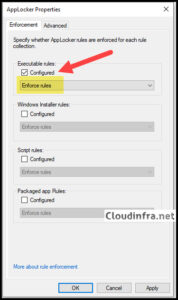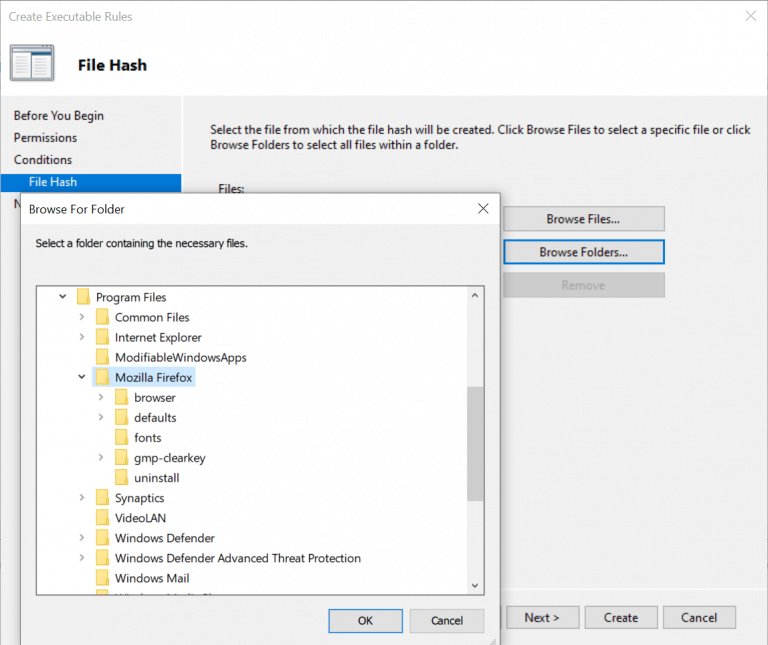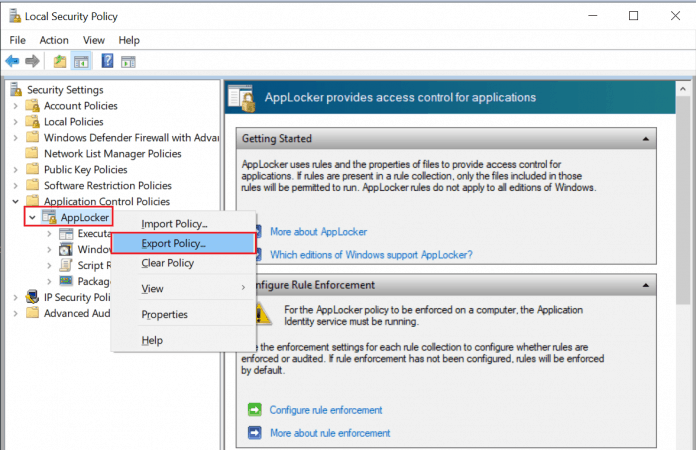

- APPLOCKER POLICY INTUNE .EXE
- APPLOCKER POLICY INTUNE UPDATE
- APPLOCKER POLICY INTUNE WINDOWS 10
- APPLOCKER POLICY INTUNE SOFTWARE
Although it might seem obvious please remember that deploying any kind of application control in enforced mode could break things without testing it first. Once you have added all rule collection types it will look something like this:ĭon’t forget to assign the profile to all users and/or devices you want to target. The Value text field must contain each rule collection xml section including and as marked here in Notepad++: Here’s an example for the EXE rule collection: Vendor/MSFT/AppLocker/ApplicationLaunchRestrictions/Native/DLL/Policyįind out more in the official AppLocker CSP documentation:ĭata type has to be set to “String”, Value equals each section from the AppLocker xml. Vendor/MSFT/AppLocker/ApplicationLaunchRestrictions/Native/StoreApps/Policy Vendor/MSFT/AppLocker/ApplicationLaunchRestrictions/Native/Script/Policy Vendor/MSFT/AppLocker/ApplicationLaunchRestrictions/Native/MSI/Policy

Vendor/MSFT/AppLocker/ApplicationLaunchRestrictions/Native/EXE/Policy
APPLOCKER POLICY INTUNE WINDOWS 10
Now we need to jump over to the Intune console to create a new Windows 10 configuration profile using the “Custom” profile type:įor each of the five different rule collections a distinct entry must be added. Even in a cloud-only scenario with Azure AD joined clients you can still use the latter to build the policy.

Configuration in Intuneįirst export your AppLocker configuration from either the Group Policy Management Console in Active Directory or from your local GPEdit Console. I will focus on how you can shift it to Intune for deployment and Microsoft Defender ATP’s Advanced Hunting capabilities for monitoring and policy refinement. In this post I assume that you are already some kind of familiar with AppLocker. It is one of my recommendations for a secure Windows 10 baseline.
APPLOCKER POLICY INTUNE SOFTWARE
Although it is not the best solution from a technical point of view (there’s Windows Defender Application Control including TPM-enforced policy signing) it is still a good way to build a quick solution to stop users from installing software or executing unwanted applications. So in the end the answer is not to difficult, but unless you go digging in to the fact that modern apps are treated differently by AppLocker and GPO’s will disable the service before cleaning house, then this blog may be useful.In this post I will give you a quick overview about cloud configuration of AppLocker using Intune and MDATP.ĪppLocker has been with us for quite some time now reaching back all the way to good old Windows 7. Short answer was to keep the GPO’s enabled but remove ALL of the Applocker rules, refresh the GPO’s several times until the Packaged apps start to work again and then you can remove the GPO.
APPLOCKER POLICY INTUNE UPDATE
Turns out that when you remove the GPO from workstations the Applocker service gets disabled before it can update it’s policies so the policies remain intact. It is almost as if once the Applocker rules are applied they are never removed.Īfter a little more digging I found this article: Problem: AppLocker Rules Still Enforced After the Service is Stopped However, after removing the GPO, refreshing the GPO’s (GPUpdate /force) and rebooting several times the error still occurs.
APPLOCKER POLICY INTUNE .EXE
exe based rules, Windows will automatically disable ALL modern apps unless unlocked by specific AppLocker rules.

These rules target the new Modern UI style apps. Under Windows 8.x and 10, the new applications require new AppLocker rules called Package App Rules. Looking at the event logs, the AppLocker event log reads: “ No packaged apps can be executed while Exe rules are being enforced and no packaged app rules have been configured” Now I know I have some AppLocker GPO’s in the environment that prevent users from running applications under their user folder (C:\User\Username) but that does not explain why these apps are not running as they are not run from one of these locations. Before they join the domain all apps are functioning fine, however, as soon as one of them joins the domain ALL the Windows 10 packaged apps stop working even the start menu (Cortana) doesn’t work and the Edge browser does not appear on the taskbar. In my lab I had newly built Windows 10 Enterprise PC’s that are joined to a domain. I know that this is not a System Center related post but I just spent the good part of 2 hours pulling my hair out over this issue so I thought I better have something to show for it at the end of it all.


 0 kommentar(er)
0 kommentar(er)
